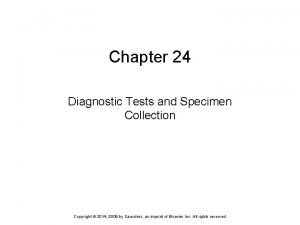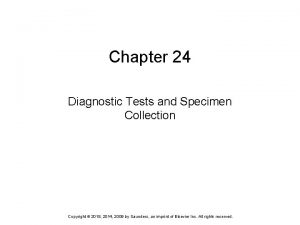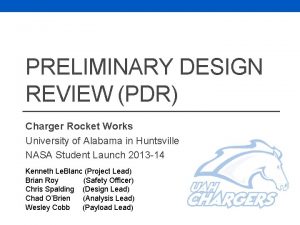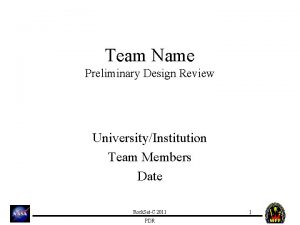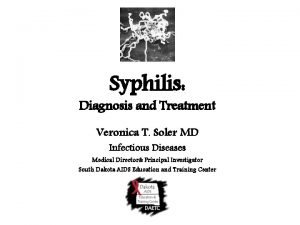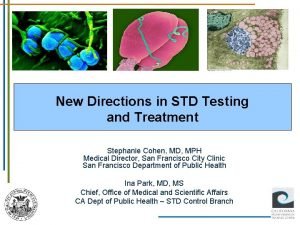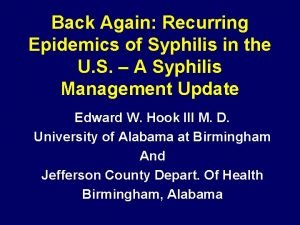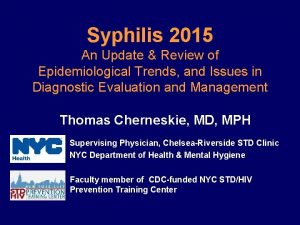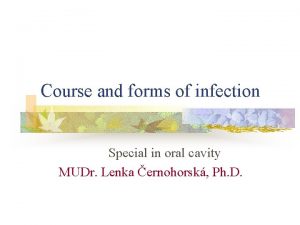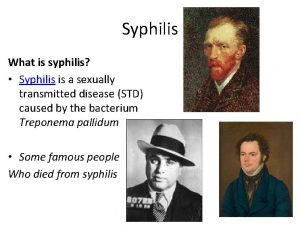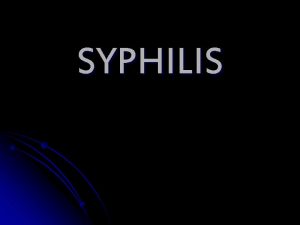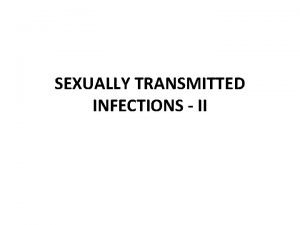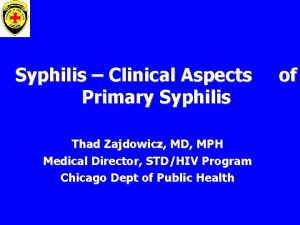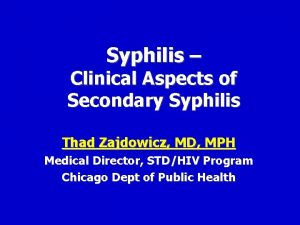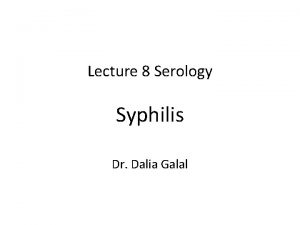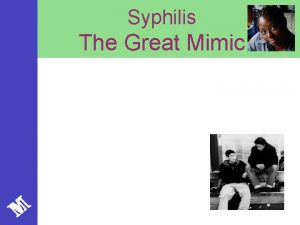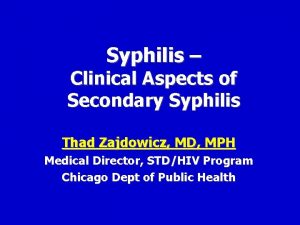Rapid Diagnostic Tests for Syphilis A Preliminary Review

















- Slides: 17

Rapid Diagnostic Tests for Syphilis A Preliminary Review of the U. S. Clinical Data M Sutton, S Zackery, C Ciesielski, M Zajackowski, M Santana, C Langley, L Bernard, V Pope, M Fears, R Johnson, L Markowitz

Background n Syphilis is diagnosed in the U. S. by a nontreponemal screening test and a treponemal confirmatory test. q q n on-site RPR plus offsite treponemal test, OR RPR and treponemal tests are sent offsite (turn-around time up to 1 week or more). Rapid immunochromatographic (ICS) diagnostic tests: q treponemal-based tests q can provide results in 15 minutes q may potentially be of use in non-traditional settings n Rapid ICS tests for syphilis are not FDA-cleared for use in the US. n A U. S. based study was conceived to evaluate these rapid diagnostics for syphilis.

Multi-site study of rapid diagnostic syphilis assays of persons attending STD clinics in high syphilis morbidity areas n Cross-sectional study n 3 ICS strips included vary by which Treponema pallidum antigens are present on the test band region n Two U. S. sites are currently evaluating the performance of 3 rapid diagnostic strips

ICS Strip

Immunochromatographic Strip (ICS) Rapid Diagnostics for Syphilis Interpretation of Results n n I Membrane strip based immunoassay Test procedure q q Recombinant T. pallidum antigen is coated on the test band region. Sample is placed on application pad and reacts with antigen-colloidal gold conjugate. If T. pallidum antibody is present an antigen-antibodyantigen gold complex will form (evident by line in the test area). Line should always appear in control region. Application Pad I Test Line Control Line Positive Sample I I Negative Sample I Inconclusive Absorbent Pad

Objectives n To evaluate ICS test performance using finger stick, whole blood, serum, and plasma specimens compared to RPR and TPPA n To compare ICS test performance with serum at local sites and CDC n To evaluate ICS test performance by syphilis stage of disease

Methods I n Enrollment- consenting adults age 18 or older n Finger stick done for point-of-care testing on 1 ICS test n Blood drawn for whole blood, serum, and plasma ICS testing at local sites and serum for CDC testing for 3 ICS tests n Data collection questionnaire includes clinical assessment of syphilis stage of disease, if applicable n Persons tested and treated for syphilis if needed according to established standard of care. n ICS tests are for investigational purposes only.

Methods II n Data analyzed using Epi-Info and SAS n Results reported by comparing to clinical standard of both RPR and TP-PA results n Sensitivity= positives/ RPR (+) TP-PA (+) n Specificity= negatives/RPR (-) TP-PA (-) n Syphilis case definitions

Results (Demographics) n n n N=383 64% male 47% African-American 32% White 18% Latino Reactive RPRs=24 q Titers < 1: 8=8 (33%) q Titers ≥ 1: 8=16 (67%) TP-PA R NR TOTAL R 20 4 24 NR 21 338 359 TOTAL 41 342 383 RPR

Results: Test performance (sensitivity) of ICS at local sites, by specimen type, compared to RPR and TP-PA Specimen Type Sensitivity (%) Test 1 Test 2 Test 3 100 47. 1 82. 4 Whole Blood (17/17) (8/17) (14/17) Serum 100 76. 5 88. 2 Plasma (17/17) (13/17) (15/17) 100 75 100 (17/17) (12/16) (17/17)

Results: Test performance (specificity) of ICS at local sites, by specimen type, compared to RPR and TP-PA Specimen Type Specificity (%) Test 1 Test 2 Test 3 97. 7 99. 7 Whole Blood (334/342) (336/337) (340/341) Serum 93. 3 96. 2 99. 1 Plasma (319/342) (327/340) (339/342) 93. 2 97. 9 99. 1 (313/336) (322/329) (331/334)

Results: Test Performance on Sera, Local Sites vs. CDC Laboratory, compared to RPR and TPPA Sensitivity Specificity

Results: Point-of-care ICS (Finger stick) compared to RPR and TP-PA n Overall (any RPR titer and reactive TP-PA) q Sensitivity=17/17 (100%) q Specificity=324/327 (99. 1%) Clinical Diagnosis of Syphilis Number of Cases Primary 1 Secondary 7 Latent 9 Previously treated (TP-PA (+) & RPR (-)) 10

Conclusions n There is a broad range of sensitivities and specificities for the 3 ICS tests in whole blood, serum, and plasma. n Test performance for sera locally is very comparable to test performance at CDC. n The ICS point-of-care (finger stick) data show sensitivities of 100% and specificities of over 99%. n ICS tests are performing well to date with various stages of disease.

Limitations n Treponemal tests are unable to differentiate between active and previously treated syphilis. n Interval analysis only; more data needed.

Summary & Future Steps n Some rapid diagnostic tests show promising performance as screening tests for syphilis in the United States. n These ICS tests require few supplies and can potentially be used in both traditional clinical settings as well as non-traditional settings. n Data collection is ongoing.

Acknowledgments n n n n n S Zackery C Ciesielski M Zajackowski M Santana C Langley L Bernard V Pope M Fears R Johnson n n n n L Markowitz J Braxton J Chapin J Lewis S Berman J Douglas B Litchfield CDC DASTLR Local Public Health Departments
 Syphilis diagnostic test
Syphilis diagnostic test Chapter 24 diagnostic tests and specimen collection
Chapter 24 diagnostic tests and specimen collection Chapter 24 diagnostic tests and specimen collection
Chapter 24 diagnostic tests and specimen collection Ace different iq tests but still
Ace different iq tests but still Preliminary design review example
Preliminary design review example Preliminary review definition
Preliminary review definition Pdr preliminary design review
Pdr preliminary design review Preliminary design review example
Preliminary design review example Syphilis titer chart
Syphilis titer chart Syphilis titer chart
Syphilis titer chart Tabes dorsalis syphilis
Tabes dorsalis syphilis Doxycycline chlamydia dosage
Doxycycline chlamydia dosage Syphilis titer chart
Syphilis titer chart Spirochetales
Spirochetales Syphilis morphology
Syphilis morphology Syphilis
Syphilis Bacteria causing syphilis
Bacteria causing syphilis Oportunne
Oportunne

